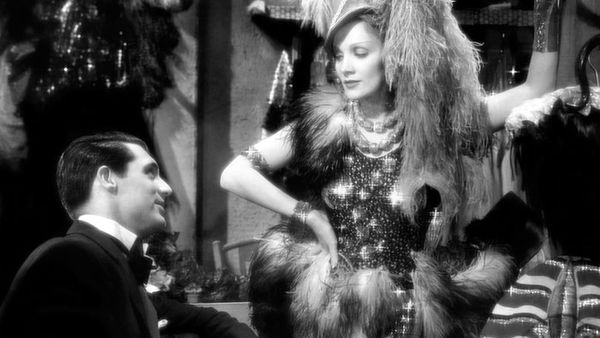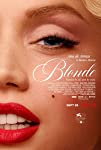Eye For Film >> Movies >> Blonde (2022) Film Review
Blonde
Reviewed by: Nikola Jovic

“Can you see her? [...] Only in the mirror I could see myself. [...] Look, Norma Jeane. There she is. Your magic friend.“ While looking at Marilyn Monroe standing in front of the mirror, bare in the lustful embrace of Cass Chaplin (played by Ana de Armas and Xavier Samuel respectively), one might indeed reflect on Cass’s words: can we really see her? We may have the perfect recreations of iconic shots and images, but did we really get to see the person behind the lushly veiled appearances? Regardless of what your answer may be, the implications of both positive and negative answers reach two equally terrible conclusions.
In this fictionalised retelling of the story of Monroe - which is an adaptation of the novel of the same name by Joyce Carol Oates from 2000 - after a stylish slo-mo rendering of the famous “delicious breeze” scene from The Seven Year Itch, the film sets its framing device by going back to a particular time in Marilyn’s life — or should we say, Norma’s life — when her mentally ill mother Gladys (Julianne Nicholson) first showed her the picture of a man she claimed to be Norma’s father (Tygh Runyan). An event that is going to shape her every subsequent relationship, and maybe even her entire life. Soon after, a fire broke out in the Hollywood Hills, ravaging their home, leading to the sequence of events that will land Gladys in a mental institution for being unwell to raise her child, and Marilyn to be taken up by her neighbours, only to be left at the orphanage soon after. This sets Norma on a path of looking for love, and trying to grapple with ideas of being unlovable and unfit to be loved, and whether she’s able to return those feelings as well. A path that leads her to become arguably the most lovable person on the planet. A path towards an early death.
This is not a typical biopic, and yet a similar formula is at play here as well. We have an event in one person’s life that is going to frame our viewing of their entire biography, giving us a focal point and a motivation for all, or most, of their decisions. While that formula is usually a deceptive screenwriting tool for compressing time in order to tell a well-rounded cohesive story, in this case, the effect is almost entirely the opposite. Blonde is not looking to conceal the fact that it strays away from the person, nor is it trying to represent the person. We can almost say that it’s trying to give the trick away, since what we’re dealing with here is not a representation of life, but an image of an image, of another image.
Both the book, and especially Dominik’s film, are focused on using the larger than life mythos surrounding Marilyn, and are trying to paint a slightly sharper rendition of the already well known image by selectively using the original source. If Michelangelo saw the angels in marble, and he just needed to chip away all the excess material in order to release them, Oates saw rubble and dust in the angel. Only an angel needed to be smashed with a hammer to reduce it, or as Oates would probably argue, release the truth about death, hidden behind the beautiful angel-like appearance.
Although her novel was based on the extensive research, she makes it no secret that the facts are stretched to reveal the bleak truth about the abuse of women, and death in the face of that abuse. Or, to quote from the book: “For my skin is my soul. There is no soul otherwise.” The titular character isn’t Norma, nor is she even called Marilyn. She’s just a blonde. A complete reduction of her identity to that image, predestined for death.
This is a place where Dominik takes this interpretation into his own aesthetic interests. Dominik’s film isn’t so much concerned with the theme of death, and is more a contemplation of the nature of the image, and the image of the image. While the book starts out with a poetic first-person about the night of August 3, 1963, where Death is delivering to her a package with no return address, Dominik starts with the flashes from photos being taken, as Marilyn is recreating the famous scene from the Billy Wilder picture. The first shot is of her bottom, and the very scene is a recreation of an iconic scene, and what follows is again a scene where there is a picture of a man that ends up colonising her mind for the rest of her life. While Oates makes a statement about patriarchy leading to death, Dominik uses both the novel and Marilyn to deliver a statement of how representation leads to death.
In that regard, both Oates and Dominik are doubling in the roles of morticians cosplaying as obstetricians in the morgue, while also drawing attention to the fact that the public’s relationship with Marilyn's legacy operates in this manner. Norma’s dead flesh is put up for examination and display — and whether it’s the decision to prop her up as an icon, or to pull her down and examine her — everyone may do with it what he or she may please. Where is Norma in all of that?
In that way, Dominik takes these well-known images of that beloved icon and uses them to subvert expectations. When the general public saw extreme attention to detail in recreating iconic shots, in the film's press releases, teasers and trailers, they all hoped to see that sentiment reflected in storytelling. What they all forgot was that those images weren’t slices of life, but composed images for public consumption. The images of Norma's lovemaking with Cass Chaplin and Eddy Robinson Jr. (Evan Williams), where in motion the colour spillage and distortions make the entire moment seem like they’re shadowy figures feasting on her body. Shots like that very well may be the biggest problem with the otherwise well-stylised and lushly lensed film. If we consider that this is doing Norma Jeane justice, by presenting a distorted and exaggerated, almost three-hour torture fest with no hope for the entirety of its running time — then we’re participating in that abuse years after the fact. What’s the other option? That option is that there is no Norma Jeane, to begin with. Like with the Cass Chaplin quote, an image in the mirror is all there is. There are only beautiful bodies to be desired and devoured.
All of this may very well be interesting to ponder on but after we take aside all well-intentioned intellectualising, and all the nice-looking shots, what we have are almost three hours of over-aestheticised torture. A story about a woman who asks herself why she isn't worthy of love, like with every other family, and the only conclusion that is to be drawn is that she was predestined for death. There are no lessons to be learned, no revelations to be unveiled, and no changes to be made. Then again, wouldn’t it be weird and kind of sacrilege to expect all of that in a story of Monroe's tragic life? This bleak, one-tone film, feels cynical in its approach, but then again, anything else would have been an even bigger misstep in the wrong direction. Looking at it that way, Blonde is a film one can throw many negative adjectives at, as it pushes all of our buttons, but it feels like the exact movie that needed to be made. For better or worse.
Reviewed on: 19 Feb 2023
















